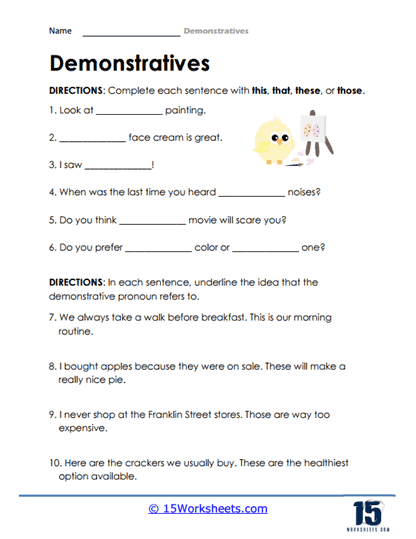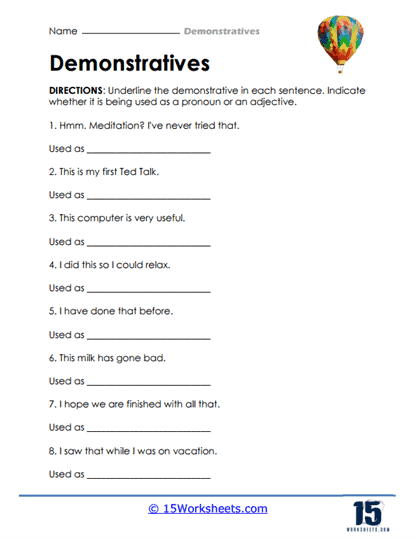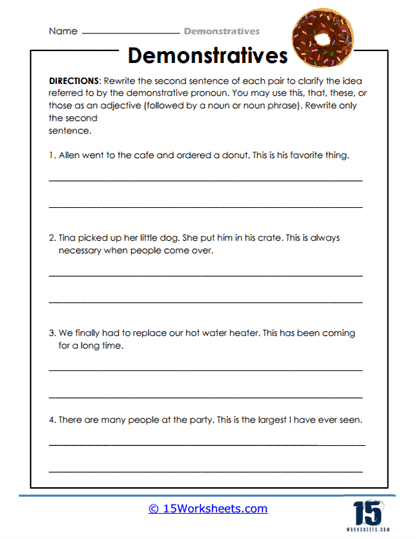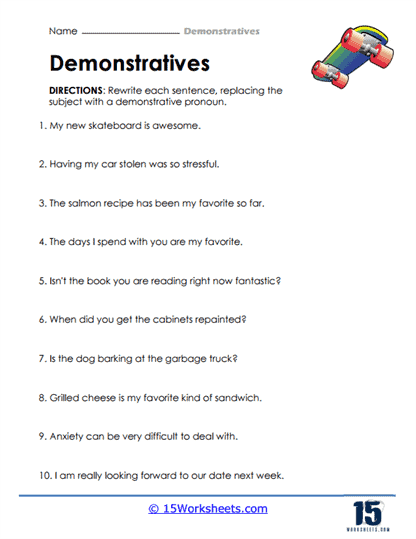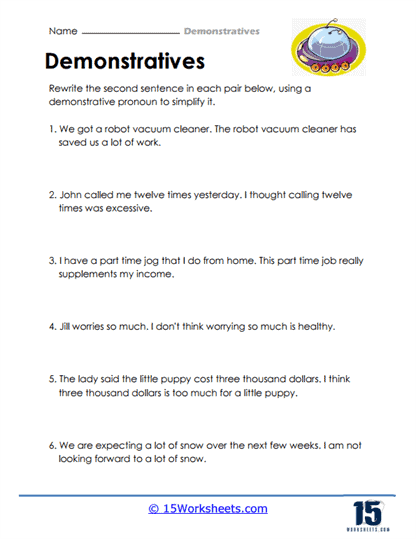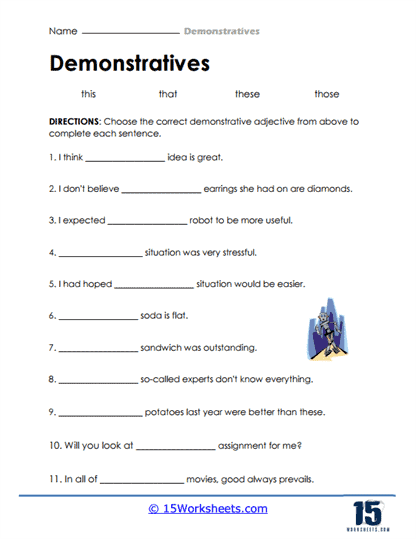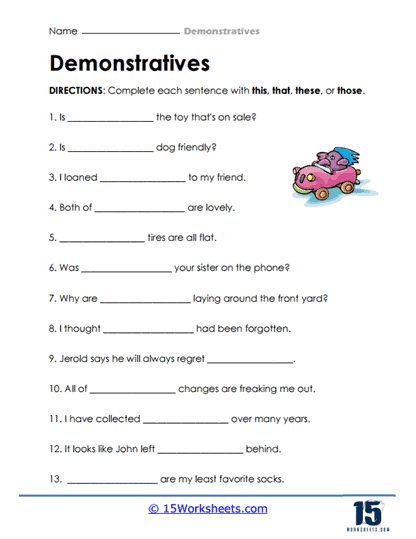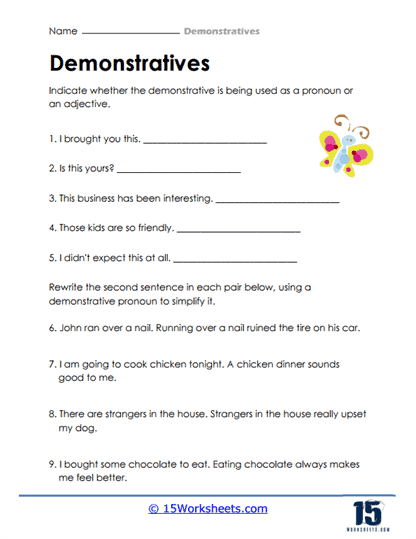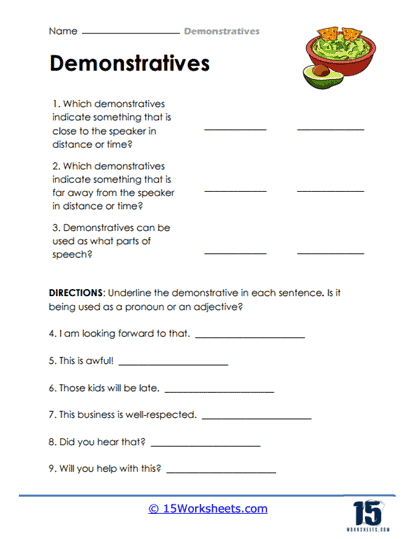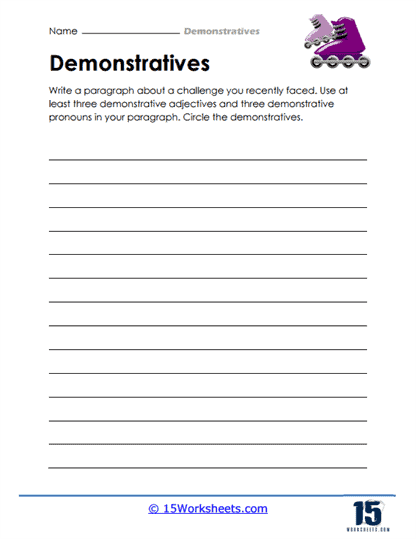Demonstratives Worksheets
All About These 15 Worksheets
These demonstratives worksheets are designed to help students understand and practice the use of demonstrative pronouns and adjectives in English. Demonstratives are words used to point to specific people, places, or things, and they are an essential part of English grammar.
These worksheets include a variety of exercises to help students identify and use different types of demonstratives correctly. Some examples of these exercises include:
- Sentence completion exercises – Students complete sentences by adding the correct demonstrative.
- Identification exercises – Students identify the demonstratives in sentences by underlining them.
- Sentence transformations – Students rewrite sentences using different forms of demonstratives.
- Writing exercises – Students write their own sentences using demonstratives.
The first worksheet in this collection also includes an explanation and examples of different types of demonstratives, such as “this,” “that,” “these,” and “those”. This provides the students with a good foundation of knowledge before answering the next worksheets which require further mastery on this topic.
A Look At The Individual Worksheets
Spotting the Culprits – “Find and Underline,” “Fill in the Blanks,” and “Completing Sentences”
The adventure begins with students donning their detective hats in “Find and Underline,” where they scour sentences to identify demonstrative pronouns and adjectives. “Fill in the Blanks” challenges them to select the appropriate demonstrative to complete sentences, ensuring they grasp the nuances of each. In “Completing Sentences,” learners craft their own sentences, reinforcing their understanding through creation.
Diving Deeper – “Identification and Application,” “Ideas and Indicators,” and “Unraveling the Connection”
These worksheets invite students to explore the relationships between demonstratives and the nouns they modify. “Identification and Application” tasks them with pinpointing demonstratives and applying them in varied contexts. “Ideas and Indicators” delves into how demonstratives signal specific ideas or objects, while “Unraveling the Connection” encourages learners to connect demonstratives with their corresponding nouns, fostering a deeper comprehension.
Role Reversal – “As a Pronoun or Adjective?” and “Clarity Through Rewriting”
Understanding the dual nature of demonstratives is key. “As a Pronoun or Adjective?” challenges students to distinguish between demonstratives used independently and those modifying nouns. “Clarity Through Rewriting” offers practice in refining sentences for clarity, emphasizing the correct use of demonstratives to convey precise meaning.
Switching Perspectives – “Subject Swap” and “Simplification Challenge”
These exercises encourage flexibility in sentence construction. “Subject Swap” has students rephrase sentences, altering subjects and demonstratives to see how meaning shifts. The “Simplification Challenge” pushes them to distill complex sentences, focusing on the effective use of demonstratives to maintain clarity and conciseness.
Mastery and Application – “Demonstrative Descriptions,” “Sentence Completion with Precision,” “Analyzing and Rewriting,” “Understanding Usage In Context,” and “Tackling Obstacles”
The final set of worksheets solidifies students’ command over demonstratives. “Demonstrative Descriptions” prompts them to create vivid descriptions using demonstratives. “Sentence Completion with Precision” and “Analyzing and Rewriting” hone their skills in crafting and refining sentences. “Understanding Usage In Context” places demonstratives within real-world scenarios, and “Tackling Obstacles” presents challenging exercises to test their proficiency.
What are Demonstratives and why do they matter?
Demonstratives are words used to point to specific people, places, or things. They are a type of pronoun or adjective that indicate the location or proximity of an object in relation to the speaker or listener. In English, there are four main types of demonstratives: “this,” “that,” “these,” and “those.”
Here is a brief explanation of each type of demonstrative:
“This” is used to refer to a singular object that is close to the speaker. For example, “This pen is mine.”
“That” is used to refer to a singular object that is farther away from the speaker. For example, “That book on the shelf is interesting.”
“These” is used to refer to multiple objects that are close to the speaker. For example, “These shoes are comfortable.”
“Those” is used to refer to multiple objects that are farther away from the speaker. For example, “Those houses across the street are expensive.”
Demonstratives are used in everyday conversation and writing to help indicate the location or proximity of objects and to provide clarity and specificity in communication. Understanding and using demonstratives correctly is an important part of English grammar, and students should practice identifying and using them in their speaking and writing to improve their language proficiency.
How do you determine if a Demonstrative is used as a pronoun or as an adjective?
In several of these worksheets, students will be asked to identify whether a demonstrative is used as a pronoun or as an adjective in a sentence. To determine whether a demonstrative is being used as an adjective or a pronoun in a sentence, it’s important to look at the role it’s playing in the sentence and its relationship to other words.
When used as an adjective, a demonstrative modifies a noun or a pronoun by specifying its proximity or location. In this case, the demonstrative comes before the noun it modifies. For example:
This book is interesting. (demonstrative “this” is used as an adjective modifying the noun “book”)
Those shoes are expensive. (demonstrative “those” is used as an adjective modifying the noun “shoes”)
On the other hand, when used as a pronoun, a demonstrative takes the place of a noun and stands alone in place of the noun. In this case, the demonstrative can be used by itself to refer to an object that has already been mentioned or is clear from context. For example:
I want this. (demonstrative “this” is used as a pronoun, replacing the noun that has already been mentioned)
Those are mine. (demonstrative “those” is used as a pronoun, referring to an object that is clear from context)
In some cases, a demonstrative can be used both as an adjective and a pronoun in the same sentence. For example:
This is my book. I like this. (demonstrative “this” is used as an adjective modifying the noun “book” in the first sentence, and as a pronoun standing alone in the second sentence)
Overall, understanding the context and function of the demonstrative in a sentence can help determine whether it is being used as an adjective or a pronoun.






